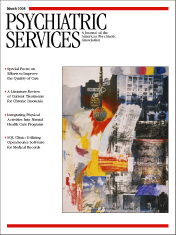The Automobile Way of Life
To the Editor: The drawing on the December 2004 cover, "Christmas Shoppers: Madison Square" [see below], which depicts street life in the early years of the 20th century, brings back memories of the time when streets functioned not merely for transportation but as social, economic, and recreational gathering places. At one time, streets provided a rich communal setting, not arteries of traffic. The streets are now monopolized by the automobile, which has displaced children, pedestrians, bicycles, and streetcars—in brief, everything but other automobiles. In 1908 in the Yale Law Journal, H. B. Brown, a retired U.S. Supreme Court Justice, urged the courts not to disregard the rights of others in favor of the motorist. His plea went unheeded.
To this day, psychiatrists devote little or no attention to the deleterious effect of the proliferation of automobiles. I do not recall even one session at the annual meeting of the American Psychiatric Association addressing mental health and the automobile way of life.
Dr. Slovenko is professor of law and psychiatry at Wayne State University Law School in Detroit.

.



